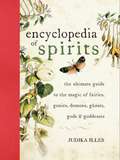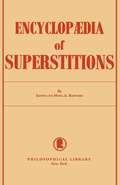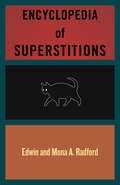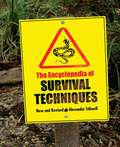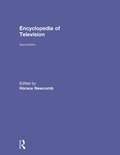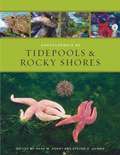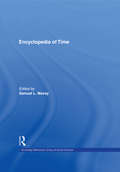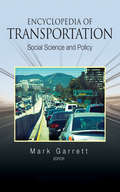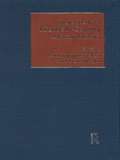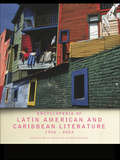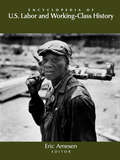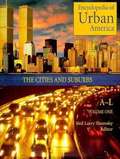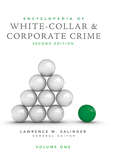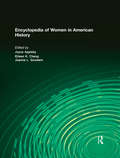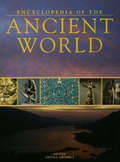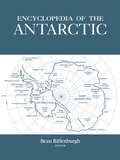- Table View
- List View
Encyclopedia of Social Theory
by Austin Harrington Hans-Peter Müller Barbara L. MarshallThe Encyclopedia of Social Theory contains over 500 entries varying from concise definitions of key terms and short biographies of key theorists to comprehensive surveys of leading concepts, debates, themes and schools. The object of the Encyclopedia has been to give thorough coverage of the central topics in theoretical sociology as well as terms
Encyclopedia of Spirits: The Ultimate Guide to the Magic of Fairies, Genies, Demons, Ghosts, Gods and Goddesses (Witchcraft & Spells)
by Judika IllesEnter the World of Spirits! The Encyclopedia of Spirits is a comprehensive and entertaining A to Z of spirits from around this world and the next. Within these pages meet love goddesses and disease demons, guardians of children and guardians of cadavers. Discover Celtic goddesses and goddesses of the Kabbalah, female Buddhas, African Powers, Dragon Ladies, White Ladies, Black Madonnas, the Green Man, the Green Fairy, lots and lots of ghosts, djinn, mermaids, fairies, and more. From the beneficent to the mischievous, working with these spirits can bring good fortune, lasting love, health, fertility, revenge, and relief. Discover: The true identities of over one thousand spirits (as well as their likes and dislikes) How to communicate with specific spirits for your own benefit How to recognize these spirits when they manifest themselves The mythological and historical events associated with specific spirits The colors, days, numbers, and astrological signs associated with specific spirits The Encyclopedia of Spirits also provides an overview of the role of spirit communication throughout history and a general guide to working with spirits. No matter what your life's problems or desires, this book can guide you to the right spirits who can help fulfill your dreams. For the spiritual adept, the amateur, or the simply curious, the Encyclopedia of Spirits will inform, inspire, and delight.
Encyclopedia of Superstitions
by Edwin Radford Mona A. RadfordContaining more that two thousand supersitions of Britain ranging over the past six hundred years, and extending down to the present day, this book demonstrates that superstitions are world-wide and inherent in all peoples of the world in exactly identical forms of fear and avoidance.
Encyclopedia of Superstitions: An Improved System Of Phrenology, Mesmerism, Trance And Mind Reading
by Edwin Radford Mona A. Radford&“For the expert investigation of the human will to believe, we recommend The Encyclopedia of Superstitions.&”—The New York Times Why is it said that breaking a mirror or walking under ladders will bring bad luck and misfortunate? Ever wonder why so many people throw salt over their shoulders after spilling it, or wish on shooting stars? The Encyclopedia of Superstitions holds the answers to these questions and more. This classic and captivating reference book catalogs the origins of hundreds of superstitious beliefs and includes a rich history of charms, spells, folklore, and rural remedies drawn from cultures around the world used to commemorate births, marriages, deaths, to ward off evil, or invite good fortune. Edwin and Mona A. Radford uncover why catching a falling leaf in autumn is believed to stave off colds all winter and explain the traditional Norse mythological roots of kissing under the mistletoe at Christmas. They explore the myriad of beliefs surrounding the moon or what spotting a rainbow portends and why. This thought-provoking collection provides a wealth of entertaining entries—stories that have the power to thrill, intrigue, and perhaps send a chill down the spine of even the most skeptical of readers.
Encyclopedia of Survival Techniques
by Alexander StilwellThis state-of-the-art manual has already sold more than 45,000 paperback copies and is now completely updated and revised with new sections on transportation (such as carjacking or road-rage incidents), defending against terrorists (how to react to a suspicious package or behavior, for example), and information about numerous self-defense techniques. This survival guide now covers the world—any terrain, all climates—with hundreds of line drawings showing details on making tools and rafts, preserving food, applying first aid, and emerging alive from natural disasters, fires, deserts, shipwrecks, icy mountains, and much more. This is the complete answer book for frightening situations, and no one should leave home without it.
Encyclopedia of Television
by Horace NewcombThe Encyclopedia of Television, second edtion is the first major reference work to provide description, history, analysis, and information on more than 1100 subjects related to television in its international context.For a full list of entries, contributors, and more, visit the Encyclo pedia of Television, 2nd edition website.
Encyclopedia of Tidepools and Rocky Shores
by Steven D. Gaines Mark W. DennyThis comprehensive encyclopedia is an authoritative, one-stop reference for everyone interested in the biology and ecology of the fascinating and uniquely accessible environment. Conveniently arranged alphabetically, nearly 200 wide-ranging entries written in clear language by scientists from around the world provide a state of the art picture of tidepools and rocky shore science.
Encyclopedia of Time
by Samuel L. MaceyFirst published in 1994. Routledge is an imprint of Taylor & Francis, an informa company.
Encyclopedia of Transportation: Social Science and Policy
by Dr Mark E. GarrettViewing transportation through the lens of current social, economic, and policy aspects, this four-volume reference work explores the topic of transportation across multiple disciplines within the social sciences and related areas, including geography, public policy, business, and economics. The book’s articles, all written by experts in the field, seek to answer such questions as: What has been the legacy, not just economically but politically and socially as well, of President Eisenhower’s modern interstate highway system in America? With that system and the infrastructure that supports it now in a state of decline and decay, what’s the best path for the future at a time of enormous fiscal constraints? Should California politicians plunge ahead with plans for a high-speed rail that every expert says—despite the allure—will go largely unused and will never pay back the massive investment while at this very moment potholes go unfilled all across the state? What path is best for emerging countries to keep pace with dramatic economic growth for their part? What are the social and financial costs of gridlock in our cities? Features: Approximately 675 signed articles authored by prominent scholars are arranged in A-to-Z fashion and conclude with Further Readings and cross references. A Chronology helps readers put individual events into historical context; a Reader’s Guide organizes entries by broad topical or thematic areas; a detailed index helps users quickly locate entries of most immediate interest; and a Resource Guide provides a list of journals, books, and associations and their websites. While articles were written to avoid jargon as much as possible, a Glossary provides quick definitions of technical terms. To ensure full, well-rounded coverage of the field, the General Editor with expertise in urban planning, public policy, and the environment worked alongside a Consulting Editor with a background in Civil Engineering. The index, Reader’s Guide, and cross references combine for thorough search-and-browse capabilities in the electronic edition. Available in both print and electronic formats, Encyclopedia of Transportation is an ideal reference for libraries and those who want to explore the issues that surround transportation in the United States and around the world.
Encyclopedia of Twentieth-Century African History
by Paul Tiyambe Zeleza Dickson EyohWith nearly two hundred and fifty individually signed entries, the Encyclopedia of Twentieth-Century African History explores the ways in which the peoples of Africa and their politics, states, societies, economies, environments, cultures and arts were transformed during the course of that Janus-faced century. Overseen by a diverse and distinguished international team of consultant editors, the Encyclopedia provides a thorough examination of the global and local forces that shaped the changes that the continent underwent. Combining essential factual description with evaluation and analysis, the entries tease out patterns from across the continent as a whole, as well as within particular regions and countries: it is the first work of its kind to present such a comprehensive overview of twentieth-century African history. With full indexes and a thematic entry list, together with ample cross-referencing and suggestions for further reading, the Encyclopedia will be welcomed as an essential work of reference by both scholar and student of twentieth-century African history.Choice Outstanding Academic Title 2004
Encyclopedia of Twentieth-Century Latin American and Caribbean Literature, 1900-2003
by Daniel Balderston Mike GonzalezThe Encyclopedia of Twentieth-Century Latin American and Caribbean Literature, 1900–2003 draws together entries on all aspects of literature including authors, critics, major works, magazines, genres, schools and movements in these regions from the beginning of the twentieth century to the present day. With more than 200 entries written by a team of international contributors, this Encyclopedia successfully covers the popular to the esoteric.The Encyclopedia is an invaluable reference resource for those studying Latin American and/or Caribbean literature as well as being of huge interest to those folowing Spanish or Portuguese language courses.
Encyclopedia of Twentieth-Century Photography, 3-Volume Set
by Lynne WarrenThe Encyclopedia of Twentieth-Century Photography explores the vast international scope of twentieth-century photography and explains that history with a wide-ranging, interdisciplinary manner. This unique approach covers the aesthetic history of photography as an evolving art and documentary form, while also recognizing it as a developing technology and cultural force. This Encyclopedia presents the important developments, movements, photographers, photographic institutions, and theoretical aspects of the field along with information about equipment, techniques, and practical applications of photography. To bring this history alive for the reader, the set is illustrated in black and white throughout, and each volume contains a color plate section. A useful glossary of terms is also included.
Encyclopedia of U.S. Labor and Working-Class History
by Eric ArnesenA RUSA 2007 Outstanding Reference Title The Encyclopedia of US Labor and Working-Class History provides sweeping coverage of US labor history. Containing over 650 entries, the Encyclopedia encompasses labor history from the colonial era to the present. Articles focus on states, regions, periods, economic sectors and occupations, race-relations, ethnicity, and religion, concepts and developments in labor economics, environmentalism, globalization, legal history, trade unions, strikes, organizations, individuals, management relations, and government agencies and commissions. Articles cover such issues as immigration and migratory labor, women and labor, labor in every war effort, slavery and the slave-trade, union-resistance by corporations such as Wal-Mart, and the history of cronyism and corruption, and the mafia within elements of labor history. Labor history is also considered in its representation in film, music, literature, and education. Important articles cover the perception of working-class culture, such as the surge in sympathy for the working class following September 11, 2001. Written as an objective social history, the Encyclopedia encapsulates the rise and decline, and continuous change of US labor history into the twenty-first century.
Encyclopedia of Ukraine: A-F plus Map and Gazetteer
by Volodymyr KubijovycOver thirty years in the making, the most comprehensive work in English on Ukraine is now complete: its history, people, geography, economy, and cultural heritage, both in Ukraine and in the diaspora.
Encyclopedia of Ukraine: G-K
by Volodymyr KubijovycThe appearance of Volume II of the Encyclopedia of Ukraine makes the second stage of a major publishing project. Based on twenty-five years' research by more than 100 scholars from around the world, the encyclopedia provides the most essential information about Ukraine and its people, history, geography, economy, and cultural heritage. Volume II contains entries beginning with the letters G to K, among them numerous biographies of historical figures and people currently living in and outside of Soviet Ukraine. Included are some 600 illustrations, maps, and statistical tables. The five volumes of the Encyclopedia of Ukraine will constitute a comprehensive guide to the life and culture of Ukrainians and reflect the manifold relations of Ukrainians with their neighbours and with their non-Ukrainian environments in the various countries to which they immigrated.
Encyclopedia of Ukraine: Ph-Sr
by Danylo Husar StrukOver thirty years in the making, the most comprehensive work in English on Ukraine is now complete: its history, people, geography, economy, and cultural heritage, both in Ukraine and in the diaspora.
Encyclopedia of Ukraine: St-Z
by Danylo Husar StrukOver thirty years in the making, the most comprehensive work in English on Ukraine is now complete: its history, people, geography, economy, and cultural heritage, both in Ukraine and in the diaspora.
Encyclopedia of Urban America: The Cities and Suburbs (Volume 2, M-Z)
by Neil L. ShumskyThis monumental work provides detailed definitions and context for the many terms and names encountered while studying the development and significance of the metropolis, the megalopolis, and, of course, the newly discovered edge city (among other strains of suburb). Includes 547 entries highlighting cultural and social phenomenon; economic and political issues; environmental concerns; transportation and infrastructure; ethnic and racial groups; the role of religion; and key figures in urban politics, literature, art, and music. The editor's introductory essay discusses the definition of urban and the development of urban studies.
Encyclopedia of Warfare: From the Earliest Times to the Present Day
by Adrian GilbertThe Encyclopedia of Warfare is a chronological account of the development of warfare since the beginnings of recorded history. The book is organized in 10 chapters, each of which looks at a particular era in warfare from the ancient world to the present. Each chapter includes color maps of key campaigns, as well as commentary on battles, personalities, troops, and equipment. Sidebars throughout the main narrative focus on noteworthy aspects of the history of conflict. Through its chronological organization and ample use of maps, the Encyclopedia also clearly conveys the link between war and world geographical history. A thorough yet concise exploration of combat throughout human history, this fascinating and informative reference work is an outstanding addition to any library collection.
Encyclopedia of Western Lawmen & Outlaws
by Jay Robert NashWith over 1000 entries and 400 illustrations, this volume is the most fact-packed history of the west ever assembled. Bestselling crime historian Jay Robert Nash has left no stone unturned in his search for the gunmen, train robbers, gangs, desperadoes, range warriors, gamblers, and lawmen that roamed the frontier.Contrary to popular myth, the Wild West was not a glamorous land where chivalry and courage were the custom and a man died with his boots on. It was a land of incredible hardships—brutal weather, hunger and disease, and the constant threat of violent death. Everyone carried a six-shooter, neutrality was impossible, and violence unavoidable; lawmen and shooter, neutrality was impossible, and violence unavoidable; lawmen and outlaws lived side by side, and often there was no telling one from the other. Into this land came pioneers lured by promises of great fortunes, ex-Confederate soldiers embittered by the outcome of the war, greedy cattle barons, and merchant princes. It was truly an explosive mixture.Included in this volume are all the great Western legends—Billy the Kid, Jesse and Frank James, Butch Cassidy, the Sundance Kid, Wyatt Earp, Doc Holliday, Judge Roy Bean, "Wild Bill Hickock—and a host of lesser-known figures who, though they may have missed notoriety, were equally lethal. In addition to alphabetical listings, it offers two glossaries listing the lawmen and outlaws for quick reference, a wonderful photo and illustration appendix, and an extensive bibliography of books on the American West.
Encyclopedia of White-Collar and Corporate Crime
by Lawrence M. SalingerSince the first edition of the Encyclopedia of White Collar and Corporate Crime was produced in 2004, the number and severity of these crimes have risen to the level of calamity, so much so that many experts attribute the near-Depression of 2008 to white-collar malfeasance, namely crimes of greed and excess by bankers and financial institutions. Whether the perpetrators were prosecuted or not, white-collar and corporate crime came near to collapsing the U.S. economy. In the 7 years since the first edition was produced we have also seen the largest Ponzi scheme in history (Maddoff), an ecological disaster caused by British Petroleum and its subcontractors (Gulf Oil Spill), and U.S. Defense Department contractors operating like vigilantes in Iraq (Blackwater). White-collar criminals have been busy, and the Second Edition of this encyclopedia captures what has been going on in the news and behind the scenes with new articles and updates to past articles.
Encyclopedia of Witchcraft
by Judika IllesThe author of the popular Encyclopedia of 5,000 Spells and Encyclopedia of Spirits now explores the exciting magic and power of the mystical world of witches in Encyclopedia of Witchcraft, a comprehensive reference book that covers everything you ever wanted to know about this fascinating topic.Folklore expert Judika Illes introduces readers to mythic witches, modern witches, sacred goddess witches, even demon witches, male and female witches, witches from all over the globe. She takes readers on an enchanting tour through witchcraft's history, mythology, and folklore, where they will discover a miscellany of facts including magic spells, rituals, potions, recipes, celebrations, traditions, and much more.
Encyclopedia of Women in American History
by Joyce Appleby Eileen Chang Neva GoodwinThis illustrated encyclopedia examines the unique influence and contributions of women in every era of American history, from the colonial period to the present. It not only covers the issues that have had an impact on women, but also traces the influence of women's achievements on society as a whole. Divided into three chronologically arranged volumes, the set includes historical surveys and thematic essays on central issues and political changes affecting women's lives during each period. These are followed by A-Z entries on significant events and social movements, laws, court cases and more, as well as profiles of notable American women from all walks of life and all fields of endeavor. Primary sources and original documents are included throughout.
Encyclopedia of the Ancient World
by Shona GrimblyEncyclopedia of the Ancient World is a colorful and lively examination of some of the most important civilizations that have shaped our world. Each entry concentrates on a particular civilization, or series of civilizations, and combines its history with an explanation of who the people were and how they lived. An examination of respective belief systems and myths is also included. Reflecting the latest developments in archaeology and bio-geography, LEncyclopedia of the Ancient World explains how the ancient civilizations developed, and how they came to dominate their neighbors, how they evolved, and why they eventually declined or died out. Encyclopedia of the Ancient World also features 400 full-color and black-and-white photographs, as well as specially commissioned diagrams and reconstructions, that help to illuminate life as it was lived many centuries ago. The book concludes with an extensive time-line that places the civilizations in an historic context; a bibliography of suggested further reading; a glossary of useful terms; and a comprehensive index.
Encyclopedia of the Antarctic
by Beau RiffenburghThe Antarctic is unique, geographically, politically, and scientifically. It is the most remote, hostile, and dangerous continent, while at the same time it is the most pristine and least developed. Antarctica is the only major part of the Earth's landmass not directly governed by one nation, but under the control of a Treaty, with a multitude of acceding nations. The Encyclopedia of the Antarctic brings together large quantities of information on the wide variety of factors, issues and individuals influencing and relating to the Antarctic. No comparable book currently exists for this region.The Encyclopedia of the Antarctic discusses scientific activities and topics, but the 'human element' is also a significant part of the work, with entries on history, politics, legal issues, national research programs, scientific bases, historic huts, the United Nation's 'Question of Antarctica,' compliance with the Environmental Protocol, and tourism.

